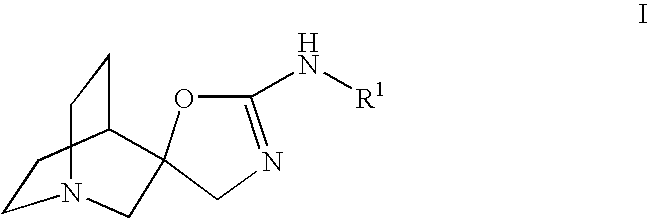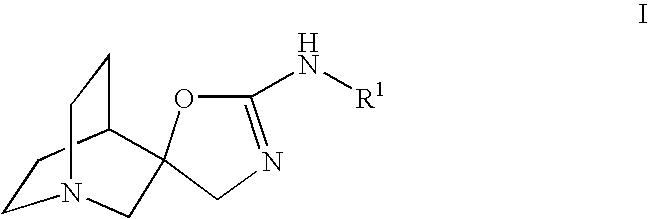Quinuclidine compounds as alpha-7 nicotinic acetylcholine receptor ligands
a technology of nicotinic acetylcholine and compound, which is applied in the field of compound, can solve the problems of schizophrenia patients having an elevated risk of suicide, major impairment of mental and social functioning, and development of other pathologies, and achieves the effect of reducing the risk of suicide in patients with schizophrenia, and reducing the risk of suicid
- Summary
- Abstract
- Description
- Claims
- Application Information
AI Technical Summary
Benefits of technology
Problems solved by technology
Method used
Image
Examples
example 1
N-(benzo[d]thiazol-2-yl)-4H-1′-azaspiro[oxazole-5,3′-bicyclo[2.2.2]octan]-2-amine
[0079]
Step A: N-(Benzo[d]thiazol-2-yl)-1H-imidazole-1-carbothioamide
[0080]
[0081]To benzo[d]thiazol-2-amine (20 g, 133 mmol) in acetonitrile (300 mL) was added 1,1′-thiocarbonyldiimidazole (30.8 g, 173 mmol). The reaction was stirred at 50° C. for 24 hours. The reaction was cooled to room temperature and the precipitate was filtered and washed with acetonitrile (2×50 mL). The yellow powder was dried in a vacuum oven (40° C.) for 2 hours. The product, N-(benzo[d]thiazol-2-yl)-1H-imidazole-1-carbothioamide (28.9 g, 111 mmol), was taken directly to the next step without any further purification.
Step B: (3-((3-Benzo[d]thiazol-2-ylthioureido)methyl)-3-hydroxy-1-ammoniobicyclo[2.2.2]octan-1-yl)trihydroborate
[0082]
[0083]To N-(benzo[d]thiazol-2-yl)-1H-imidazole-1-carbothioamide (9.2 g, 35 mmol) in N,N-dimethylformamide (100 mL) was added (3-(aminomethyl)-3-hydroxy-1-ammoniobicyclo[2.2.2]octan-1-yl)trihydroborate...
example 2
N-(5-Methoxythiazolo[5,4-b]pyridin-2-yl)-4H-1′-azaspiro[oxazole-5,3′-bicyclo[2.2.2]octan]-2-amine
[0089]
Step A: 5-Methoxythiazolo[5,4-b]pyridin-2-amine
[0090]
[0091]In a 500 ml, 3-neck flask equipped with a mechanical stirrer, dropping funnel and thermometer, acetic acid (100 mL) was added and cooled in an ice bath. Potassium thiocyanate (40 g, 412 mmol) and 6-methoxypyridin-3-amine (6.2 g, 49.9 mmol) were added to the reaction mixture. The reaction was cooled in an ice-salt bath until the reaction temperature reached 1H NMR (300 MHz, DMSO-d6) δ ppm 7.60 (1 H, d, J=8.42 Hz), 7.41 (2 H, s), 6.67 (1 H, d, J=8.78 Hz), 3.81 (3 H, s).
Step B: (3-Hydroxy-3-((3-(5-methoxythiazolo[5,4-b]pyridin-2-yl)thioureido)methyl)-1-ammoniobicyclo[2.2.2]octan-1-yl)trihydroborate
[0092]
[0093]5-Methoxythiazolo[5,4-b]pyridin-2-amine (2.4 g, 13.24 mmol) was divided among 5×20 mL screw-cap vials. To each vial was added acetonitrile (10 mL) and thiocarbonyl diimidazole (600 mg). All vials were heated at 60° C. ove...
example 3
(2-(5H-1′-Azaspiro[oxazole-4,3′-bicyclo[2.2.2]octane]-2-ylamine)benzo[d]thiazol-6-yl)pyrrolidin-1-yl)methanone
[0100]
Step A: tert-Butyl 6-(pyrrolidine-1-carbonyl)benzo[d]thiazol-2-ylcarbamate
[0101]
[0102]In a 250 ml flask was added 2-(tert-butoxycarbonyl-amino)benzo[d]thiazole-6-carboxylic acid (1.0 g, 3.4 mmol) and pyrrolidine (0.559 mL, 6.8 mmol) in tetrahydrofuran (50 mL). To this solution was added EDC (1.3 g, 6.8 mmol), 1-hydroxybenzotriaxole (1.041 g, 6.8 mmol) and Hunig's Base (2.37 mL, 13.59 mmol). The reaction was stirred at 25° C. for 1 hour. The reaction was then poured into water and dichloromethane. The water was extracted 3 times with dichloromethane and the organic layers were combined and concentrated. The residue was taken up in a small amount of dichloromethane and precipitated out with diethyl ether / hexanes. The flask was put in the freezer for 1 hour and filtered. The white precipitate was collected to yield tert-butyl 6-(pyrrolidine-1-carbonyl)benzo[d]thiazol-2-yl...
PUM
| Property | Measurement | Unit |
|---|---|---|
| pH | aaaaa | aaaaa |
| v/v | aaaaa | aaaaa |
| flow rate | aaaaa | aaaaa |
Abstract
Description
Claims
Application Information
 Login to View More
Login to View More - R&D
- Intellectual Property
- Life Sciences
- Materials
- Tech Scout
- Unparalleled Data Quality
- Higher Quality Content
- 60% Fewer Hallucinations
Browse by: Latest US Patents, China's latest patents, Technical Efficacy Thesaurus, Application Domain, Technology Topic, Popular Technical Reports.
© 2025 PatSnap. All rights reserved.Legal|Privacy policy|Modern Slavery Act Transparency Statement|Sitemap|About US| Contact US: help@patsnap.com



